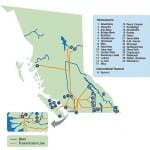Oregon and Washington State are examining new policies to regulate greenhouse gas emissions. We expect to see extension of Oregon’s Clean Fuels Program at the top of the 2015 legislative agenda and, potentially, a bill to enact a carbon tax. In Washington, on Nov. 14, the governor’s Carbon Emissions Reduction Task Force (CERT) released its report weighing the benefits of cap and trade versus a carbon tax, and a separate update of a report commissioned by the governor on clean fuels was released Oct. 29.
As members of the Pacific Coast Action Plan on Climate and Energy (PCAP), both states have committed to adopt low-carbon fuel standards and pursue carbon pricing mechanisms like cap and trade or carbon taxes. Both states will look to policy models from California and British Columbia (B.C.), fellow PCAP members.
Cap and Trade vs. Carbon Tax
In Oregon, we expect to see at least one bill to internalize economic costs of climate change.
The regulatory choice is between a carbon tax and a cap-and-trade scheme. A carbon tax puts a price on each unit of carbon emitted, as a surcharge on fuel inputs or on industrial processes. In a cap-and-trade scheme, regulators set a maximum limit for emissions from regulated sources (the “cap”), issue or auction individual permits implementing the cap, and manage an emissions trading market where businesses can buy and sell unused permit capacities.
Both approaches have advantages and disadvantages. Proponents argue that a carbon tax creates cost certainty for regulated entities—businesses can plan for increased emissions costs—however, cap-and-trade advocates point out that modeling the resulting emissions reductions is challenging. Cap and trade theoretically produces more certain environmental benefits, but skeptics decry cost uncertainty relative to a carbon tax.
B.C. taxes almost all fossil fuels burned inside the province. The Sightline Institute went so far as to call B.C.’s carbon tax “the best in North America and probably the world.” The initial 2008 tax was $10 per ton of carbon dioxide, and the tax settled at $30 per ton in July 2012. The B.C. tax is “revenue neutral,” meaning that reductions in corporate and personal income taxes offset revenue from the carbon tax. B.C. carbon emissions are down since 2008, although other factors blur the causal link. Proponents note that the carbon tax has not harmed B.C.’s economy, although the tax may disproportionately affect low-income families.
Meanwhile, California’s cap-and-trade system is entering its third year following enactment in 2006 of Assembly Bill 32, which set long-term carbon reduction goals for the state. The California market in 2014 linked with a similar program adopted by Quebec. In 2015, it will expand to encompass fuel distributors, despite strong opposition by oil producers to expansion of the program to cover transportation fuels and, in addition, sources emitting more than 25,000 metric tons of carbon dioxide equivalent annually. The program has a number of market-stabilizing features, including a price floor. It is too early to determine the program’s effect on California’s economy or emissions.
The political timing is right for introduction of an Oregon carbon tax bill this coming 2015 session, but its chances for success are less certain. In 2013, the Oregon legislature appropriated $200,000 to evaluate a carbon tax; as of this writing, the study report was expected to be released in December 2014. A carbon tax bill’s chances would depend partly on whether the tax would be revenue-neutral like B.C.’s or would add to existing tax burdens. Some believe that such a tax should be incorporated into always-elusive broad-reaching tax reform. We may also see a competing cap-and-trade bill in Oregon.
The Washington governor’s office has not firmly backed either cap and trade or a carbon tax. The recently released CERT study summarized the pros and cons of both approaches but did not recommend one over the other.
Clean Fuels Program
In Oregon, we expect to see legislation to extend or eliminate the Dec. 31, 2015, sunset date on the Oregon Clean Fuels Program. The program, authorized in 2009, aims to lower the carbon content of transportation fuel used in Oregon. The rules would require fuel importers to reduce fuel carbon content by 10% from 2010 standards by 2020. The program focuses on increasing ethanol and alternative fuel content in transportation fuels. As in California, the Oregon Clean Fuels Program has drawn opposition from the oil industry.
Washington is considering a program with similar goals. On Oct. 29, 2014, a revised draft of a report commissioned by the governor was released that examined alternatives and impacts of a low-carbon fuels standard in detail. The report was informational and did not make a recommendation. Both California and B.C. have pursued 10% carbon reductions over 10 years. The California Low Carbon Fuel Standard program (LCFS) uses a cap-and-trade approach. Petroleum importers, refiners, and wholesalers may develop low-carbon fuel products or buy LCFS credits from alternative fuel companies. The B.C. LCFS mandates the 10% carbon intensity reduction for transportation fuels and requires suppliers to incorporate renewable fuels into transportation and heating fuels.
The Obama administration has focused its carbon reduction efforts on aggressive interpretations of the Clean Air Act (especially the Section 111(d) rule) and the federal Renewable Fuels Program. However, the new Republican-controlled Congress can be expected to attempt to roll them back. In the face of federal inaction, the impetus shifts to the states. Whether West Coast states will act in an independent or coordinated fashion remains to be seen. ■
— Rick Glick (rickglick@dwt.com) is a partner in Davis Wright Tremaine’s energy and environmental practice group in the firm’s Portland, Ore. office. Merissa Moeller (merissamoeller@dwt.com) is a student at Lewis & Clark Law School.









